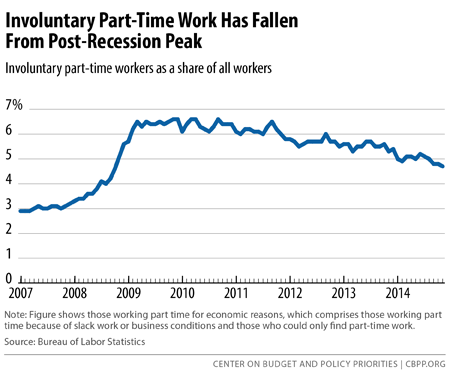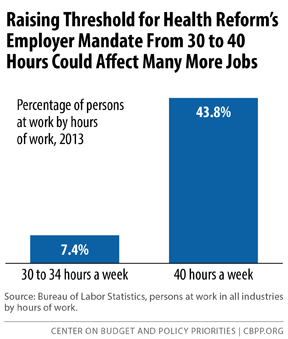Health Reform Not Causing Significant Shift to Part-Time Work
But Raising Threshold to 40 Hours a Week Would Make a Sizeable Shift Likely
By Paul N. Van de Water
Updated January 6, 2015 - Center on Budget and Policy Priorities
Congressional leaders have tentatively scheduled a House vote early in
January on a measure to raise the threshold for health reformfs employer mandate
from 30 to 40 hours.[1] The health reform law requires employers with at
least 50 full-time-equivalent workers to offer health coverage to employees who
work 30 or more hours a week or pay a penalty.[2]
House Speaker John Boehner and Senate Majority Leader Mitch McConnell call
the 30-hour threshold gan arbitrary and destructive government barrier to more
hoursh of work and propose raising it to 40 hours.[3] In reality, however, that step would lead to
fewer hours of work for employees and more part-time work — the exact
opposite of what their rhetoric about grestoringh the 40-hour work week
implies.
Recent data provide scant evidence that health reform is causing a
significant shift toward part-time work, contrary to the claims of
critics. The number of part-time workers who would rather be working full
time is shrinking. And therefs every reason to believe that health reform
will have only a small effect on the part-time share of total employment.
More important, raising the lawfs threshold from 30 hours a week to 40 hours
would make a shift toward part-time employment much more likely — not less
so. Thatfs because only a small share of workers today — 7 percent — work
30 to 34 hours a week and thus are most at risk of having their hours cut below
health reformfs threshold. In comparison, 44 percent of employees work 40
hours a week, and another several percent work 41 to 44 hours a week.
Thus, raising the threshold to 40 hours would place many more workers at risk of
having their hours reduced. In short, itfs the present legislation, not
health reform, that threatens the traditional 40-hour work week the
legislationfs sponsors say they want to protect.
Data Donft Support Claim of Big Shift to Part-Time Work
The share of part-time jobs rose sharply during the recent recession, as it
does in every recession; employers cut workersf hours when demand for the
firmfs products or services weakens. Did this share continue to grow as we
approached the start of the Affordable Care Actfs (ACAfs) employer mandate in
2015? The answer is no.
Part-time workers represent 18 percent of total employment — below
the post-recession peak of 20 percent. Since President Obama signed health
reform into law in March 2010, all of the overall increase in civilian
employment has been among people who usually work full time.[4] These data are consistent with a recent Urban
Institute analysis that found little evidence that health reform has increased
part-time work.[5]

The share of involuntary part-timers — workers whofd rather have
full-time jobs but canft find them — tells a similar story. If health
reformfs employer mandate were distorting hiring practices in the way critics
claim, wefd expect the share of involuntary part-timers to be growing.
Instead, as Figure 1 shows, it is down about two percentage points from
its peak.
To be sure, some employers have announced they are cutting certain employeesf
hours to avoid the requirement to provide health coverage to full-time workers,
but they are the exception. And while itfs too early to know exactly how
much health reform will ultimately affect the amount of part-time work, therefs
every reason to expect the impact to be small as a share of total
employment.
In particular, there simply arenft as many potentially affected workers as
the critics expect: only about 7 percent of employees work 30 to 34 hours
a week (and thus would be easiest for employers to shift below 30 hours).
Moreover, less than one-half of 1 percent of employees work 30 to 34
hours a week and are employed by businesses affected by the employer
mandate and do not have insurance.[6] And only some of these workers would likely be at
risk of having their hours cut.
gRecent research suggests that the ultimate increase in the incidence of
part-time work when the ACA provisions are fully implemented is likely to be
small, on the order of a 1 to 2 percentage point increase or less,h according to
economists at the San Francisco Federal Reserve. They note that this
conclusion gis consistent with the example of Hawaii, where part-time work
increased only slightly in the two decades following enforcement of the statefs
employer health-care mandate.h[7]
In addition, low-wage workers who work less than 30 hours a week are eligible
for subsidies to purchase health insurance in health reformfs insurance
exchanges (also known as marketplaces). For many of these workers, the
value of this health insurance subsidy would more than make up for a loss in
earnings from working slightly fewer hours.
Raising Threshold to 40 Hours Would Make Shift to Part-Time Work More Likely, Not Less
Raising the cutoff for the employer mandate from 30 hours a week to 40 hours
would make a shift toward part-time employment more likely — not less
so. Since 40 hours is the typical work week, employers could easily cut
back large numbers of employees from 40 to 39 hours so they wouldnft have to
offer them health coverage. The result would be less employer-sponsored
health coverage — and thus higher federal spending for Medicaid and premium tax
credits. In addition, the penalties collected from employers who fail to
meet the requirement to offer coverage would fall. Raising the threshold
to 40 hours would increase budget deficits by $46 billion over 2015-2024,
according to the Congressional Budget Office.[8]
As Figure 2 shows, only about 7 percent of employees work 30 to 34 hours a
week (that is, at or modestly above the health reformfs 30-hour threshold), but
44 percent of employees work 40 hours a week and would be vulnerable to
cuts in their hours if the threshold rose to 40 hours.[9]

If you exclude workers at firms that already offer health insurance and thus
wonft be tempted to cut workersf hours, more than twice as many workers would
face a high risk of reduced hours under a 40-hour threshold than under the
current 30-hour threshold, according to New York University economist Sherry
Glied and a colleague.[10]
Health reformfs employer mandate may well have some effect on hours worked,
although that hasnft yet shown up in the data. But since few workers
who lack health coverage are near the 30-hour cutoff, any such
effect is likely to be small: the employer mandate is very unlikely to
prompt much of a shift toward part-time work. Raising the cutoff to 40
hours, however, could turn the misleading claims of health reform critics into
harsh reality.
End notes:
[1] The House passed similar legislation during the 113th
Congress: H.R. 2575,The Save American Workers Act, https://www.congress.gov/113/bills/hr2575/BILLS-113hr2575pcs.pdf.
[2] Kaiser Family Foundation, gEmployer Responsibility Under
the Affordable Care Act,h updated December 17, 2014, http://kff.org/infographic/employer-responsibility-under-the-affordable-care-act/.
[3] John Boehner and Mitch McConnell, gNow We Can Get Congress
Going,h Wall Street Journal, November 5, 2014.
[4] Bureau of Labor Statistics (BLS), Labor Force
Statistics from the Current Population Survey; employment level (series
LNS12000000); employment level – part-time for economic reasons, all industries
(series LNS12032194); part-time for noneconomic reasons (series
LNS12005977). Data are as of November 2014. BLS defines part-time
work as less than 35 hours a week.
[5] Bowen Garrett and Robert Kaestner, Little Evidence of
the ACA Increasing Part-Time Work So Far, Urban Institute, September 2014,
http://www.urban.org/UploadedPDF/413217-Little-Evidence-of-the-ACA-Increasing-Part-Time-Work-So-Far.pdf.
[6] Sherry Glied and Claudia Solis-Roman, What Will Be the
Impact of the Employer Mandate on the U.S. Workforce?, The Commonwealth
Fund, October 2014, http://www.commonwealthfund.org/~/media/files/publications/issue-brief/2014/oct/1778_glied_what_will_be_impact_employer_mandate_ib_v2.pdf.
[7] Rob Valetta and Leila Bengali, gWhatfs Behind the Increase
in Part-Time Work?,h Federal Reserve Bank of San Francisco Business
Letter, August 26, 2013, http://www.frbsf.org/economic-research/publications/economic-letter/2013/august/part-time-work-employment-increase-recession/.
Since 1975, Hawaii has required nearly all employers to provide health insurance
to employees who work 20 hours or more a week for four consecutive weeks.
Employers must pay at least half the premium, and the employeefs contribution
must not exceed 1.5 percent of wages.
[8] Congressional Budget Office, Letter to the Honorable
Dave Camp, July 17, 2014, https://www.cbo.gov/publication/45544.
[9] U.S. Bureau of Labor Statistics, Labor Force Statistics
from the Current Population Survey, persons at work in agriculture and
nonagricultural industries by hours of work, http://www.bls.gov/cps/cpsaat19.htm.
[10] Glied and Solis-Roman.